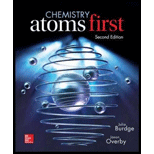
(a)
Interpretation:
The formula and name of a binary compound formed from the given elements has to be predicted.
Concept introduction:
- First, write down the given information, from which identify which acts as an anion and which acts as a cation.
- After identification of ions, look for the possibility of bond formation by equal sharing of electrons from the given elements.
- Depending upon the charge they carry, we can finally come over the formula and the name of those particular binary compounds from their respective elements.
(b)
Interpretation:
The formula and name of a binary compound formed from the given elements has to be predicted.
Concept introduction:
- First, write down the given information, from which identify which acts as an anion and which acts as a cation.
- After identification of ions, look for the possibility of bond formation by equal sharing of electrons from the given elements.
- Depending upon the charge they carry, we can finally come over the formula and the name of those particular binary compounds from their respective elements.
(c)
Interpretation:
The formula and name of a binary compound formed from the given elements has to be predicted.
Concept introduction:
- First, write down the given information, from which identify which acts as an anion and which acts as a cation.
- After identification of ions, look for the possibility of bond formation by equal sharing of electrons from the given elements.
- Depending upon the charge they carry, we can finally come over the formula and the name of those particular binary compounds from their respective elements.
(d)
Interpretation:
The formula and name of a binary compound formed from the given elements has to be predicted.
Concept introduction:
- First, write down the given information, from which identify which acts as an anion and which acts as a cation.
- After identification of ions, look for the possibility of bond formation by equal sharing of electrons from the given elements.
- Depending upon the charge they carry, we can finally come over the formula and the name of those particular binary compounds from their respective elements.
(e)
Interpretation:
The formula and name of a binary compound formed from the given elements has to be predicted.
Concept introduction:
- First, write down the given information, from which identify which acts as an anion and which acts as a cation.
- After identification of ions, look for the possibility of bond formation by equal sharing of electrons from the given elements.
- Depending upon the charge they carry, we can finally come over the formula and the name of those particular binary compounds from their respective elements.
(f)
Interpretation:
The formula and name of a binary compound formed from the given elements has to be predicted.
Concept introduction:
- First, write down the given information, from which identify which acts as an anion and which acts as a cation.
- After identification of ions, look for the possibility of bond formation by equal sharing of electrons from the given elements.
- Depending upon the charge they carry, we can finally come over the formula and the name of those particular binary compounds from their respective elements.
Want to see the full answer?
Check out a sample textbook solution
Chapter 5 Solutions
Chemistry: Atoms First
- Ca, Cl, Na, Fe, and K. Which of these elements form cations? List their symbols with charges. Which of these elements form anions? List their symbols with charges.arrow_forwardCa^2+ and S^2- as a chemical formulaarrow_forwardis the chemical formula, C2OH2N2O2, how would you write 3 molecules of this compoundarrow_forward
- Write the chemical formulas for (a) potassium sulfide, (b) calcium hydrogen carbonate c) nickel(II) perchlorate. for (d) silicon tetrabromide, (e) disulfur dichloride.arrow_forward(a) What is the formula of carbon disulfi de? (b) What is the name of PCl5? (c) Give the name and formula of the compound whose molecules each consist of two N atoms and four O atoms.arrow_forwardProvide an explanation for the way the following formula Ca5(PO4)3OH is written and state the name of all the ions involved. (Explain what the subscripted numbers indicate, why is PO4 in brackets whereas OH isn’t?)arrow_forward
- Give the name or chemical formula, as appropriate, for eachof the following acids: (a) HBrO3, (b) HBr, (c) H3PO4, (d) hypochlorousacid, (e) iodic acid, (f) sulfurous acid.arrow_forwardWrite the structural formulas of two different compounds that each has the molecular formula C4H10.arrow_forwardElements in the same group of the periodic table often form oxyanions with the same general formula. The anions are also named in a similar fashion. Based on these observations, suggest a chemical formula or name, as appropriate, for each of the following ions: (a) BrO4 -, (b) SeO3 2-, (c) arsenate ion, (d) hydrogen tellurate ion.arrow_forward
 Chemistry & Chemical ReactivityChemistryISBN:9781133949640Author:John C. Kotz, Paul M. Treichel, John Townsend, David TreichelPublisher:Cengage Learning
Chemistry & Chemical ReactivityChemistryISBN:9781133949640Author:John C. Kotz, Paul M. Treichel, John Townsend, David TreichelPublisher:Cengage Learning Chemistry & Chemical ReactivityChemistryISBN:9781337399074Author:John C. Kotz, Paul M. Treichel, John Townsend, David TreichelPublisher:Cengage Learning
Chemistry & Chemical ReactivityChemistryISBN:9781337399074Author:John C. Kotz, Paul M. Treichel, John Townsend, David TreichelPublisher:Cengage Learning Chemistry: Principles and PracticeChemistryISBN:9780534420123Author:Daniel L. Reger, Scott R. Goode, David W. Ball, Edward MercerPublisher:Cengage Learning
Chemistry: Principles and PracticeChemistryISBN:9780534420123Author:Daniel L. Reger, Scott R. Goode, David W. Ball, Edward MercerPublisher:Cengage Learning General Chemistry - Standalone book (MindTap Cour...ChemistryISBN:9781305580343Author:Steven D. Gammon, Ebbing, Darrell Ebbing, Steven D., Darrell; Gammon, Darrell Ebbing; Steven D. Gammon, Darrell D.; Gammon, Ebbing; Steven D. Gammon; DarrellPublisher:Cengage Learning
General Chemistry - Standalone book (MindTap Cour...ChemistryISBN:9781305580343Author:Steven D. Gammon, Ebbing, Darrell Ebbing, Steven D., Darrell; Gammon, Darrell Ebbing; Steven D. Gammon, Darrell D.; Gammon, Ebbing; Steven D. Gammon; DarrellPublisher:Cengage Learning Introductory Chemistry: A FoundationChemistryISBN:9781337399425Author:Steven S. Zumdahl, Donald J. DeCostePublisher:Cengage Learning
Introductory Chemistry: A FoundationChemistryISBN:9781337399425Author:Steven S. Zumdahl, Donald J. DeCostePublisher:Cengage Learning Introductory Chemistry: An Active Learning Approa...ChemistryISBN:9781305079250Author:Mark S. Cracolice, Ed PetersPublisher:Cengage Learning
Introductory Chemistry: An Active Learning Approa...ChemistryISBN:9781305079250Author:Mark S. Cracolice, Ed PetersPublisher:Cengage Learning





